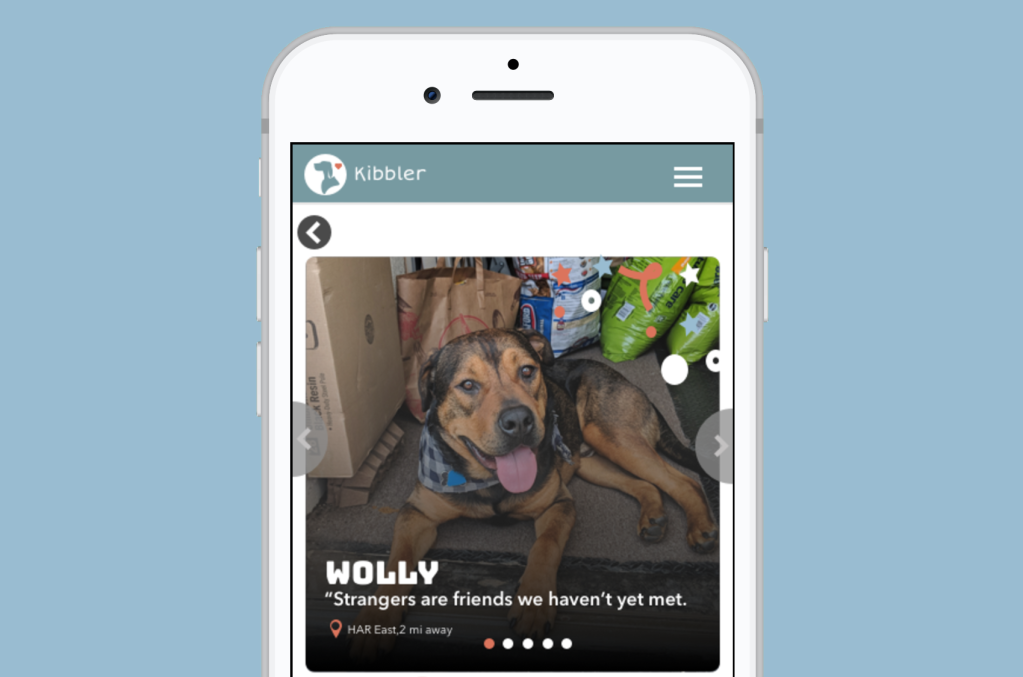
Context: Interaction Design course
Domain: Pet Adoption
Timeline: 6 weeks
Role: Design Strategist; Research
Team: Gabrielle Gayles and Sai Swaminathan
Overview
Kibbler is a mobile-first web app for animal shelters that matches potential adopters to dogs based on personality, lifestyle, and expectations of pet ownership. Kibbler obscures dog breed, age, and other factors that contribute to stereotypes and impede adoption, and elevates the prominence of a dog’s energy level, friendliness, and quirks.
Challenge
How might we increase the adoption of dogs
that suffer from stereotypes and misconceptions?

Animal shelters want all of their residents to find a forever home. However, certain dog demographics — black animals, animals with health issues, and bully breeds like pit bulls — are under-adopted and often stay in the shelter for extended periods of time. This is both emotionally taxing and financially draining for shelters.
Design Process
Starting with the wide scope of pet adoption, my team began by conducting secondary research, browsing adoption sites and resources like the ASPCA and local pet adoption services. Although the space is large, we decided to focus on adoption of dogs and cats, with adopters and adoption counselors at the center of our stakeholder map.

We did guerilla research, visiting animal shelters, and pet supply shops to observe and interview adoption events. We spoke with adoption counselors about the process of rehoming an animal in order to identify pain points in the current process, from providing shelter to homeless dogs and cats to walking potential pet owners through the application process.
We also talked to pet owners out walking their dogs about their experiences with adoption, looking for what poses the greatest challenges and what kinds of preparation they do when adopting from a shelter.
Developing and visualizing findings
From our research, we built journey maps for both pet adopters and animal adoption counselors and compared them in order to deepen our understanding of the problem space. In analyzing our secondary and guerrilla research, patterns began to emerge. There were breakdowns in the adoption process for both service provider and customer. When we built our first journey maps for these two stakeholders, we noticed overlaps in some of these breakdowns. However, the adoption application process is quite broad, and shelters tended to already intervene in these processes in different ways.
What stood out to us as most surprising from our first iteration of the journey maps was that certain animals are very difficult to adopt out; bully breeds, older animals, animals with health issues, and black animals, which adoption counselors attributed to misinformation and superstition about these animals. In the revision of our journey maps, we focused on the adoption process as it relates to the lack of perceived desirability of dogs that fall into one or more of these categories. We identified pain points on both the service provider side and the customer side, and were able to better understand the factors that drive adoption choices.

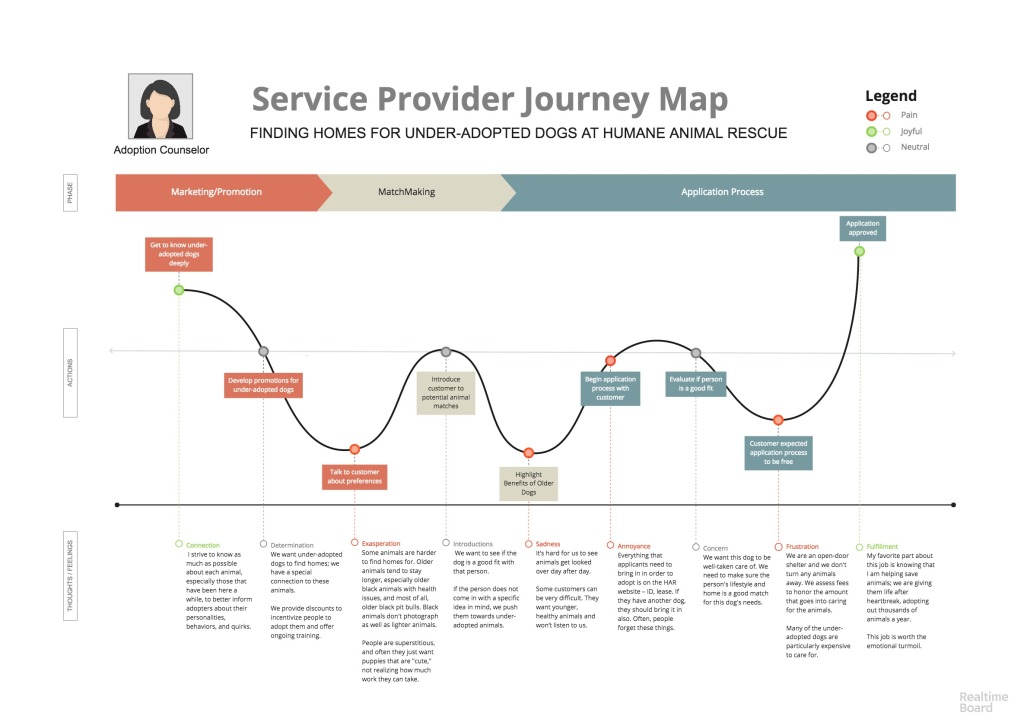
Comparing the journey maps side by side enabled us to identify the key customer and service provider pain points that could be addressed with the same solution. Namely:
- The shelter counselors wants to help under-adopted animals find homes.
- The adopter wants to feel like a hero by adopting an animal, but is overwhelmed by the paradox of choice when selecting a new life-mate
We also made use of personas in our research process by building out empathic and complex representations of our stakeholders.

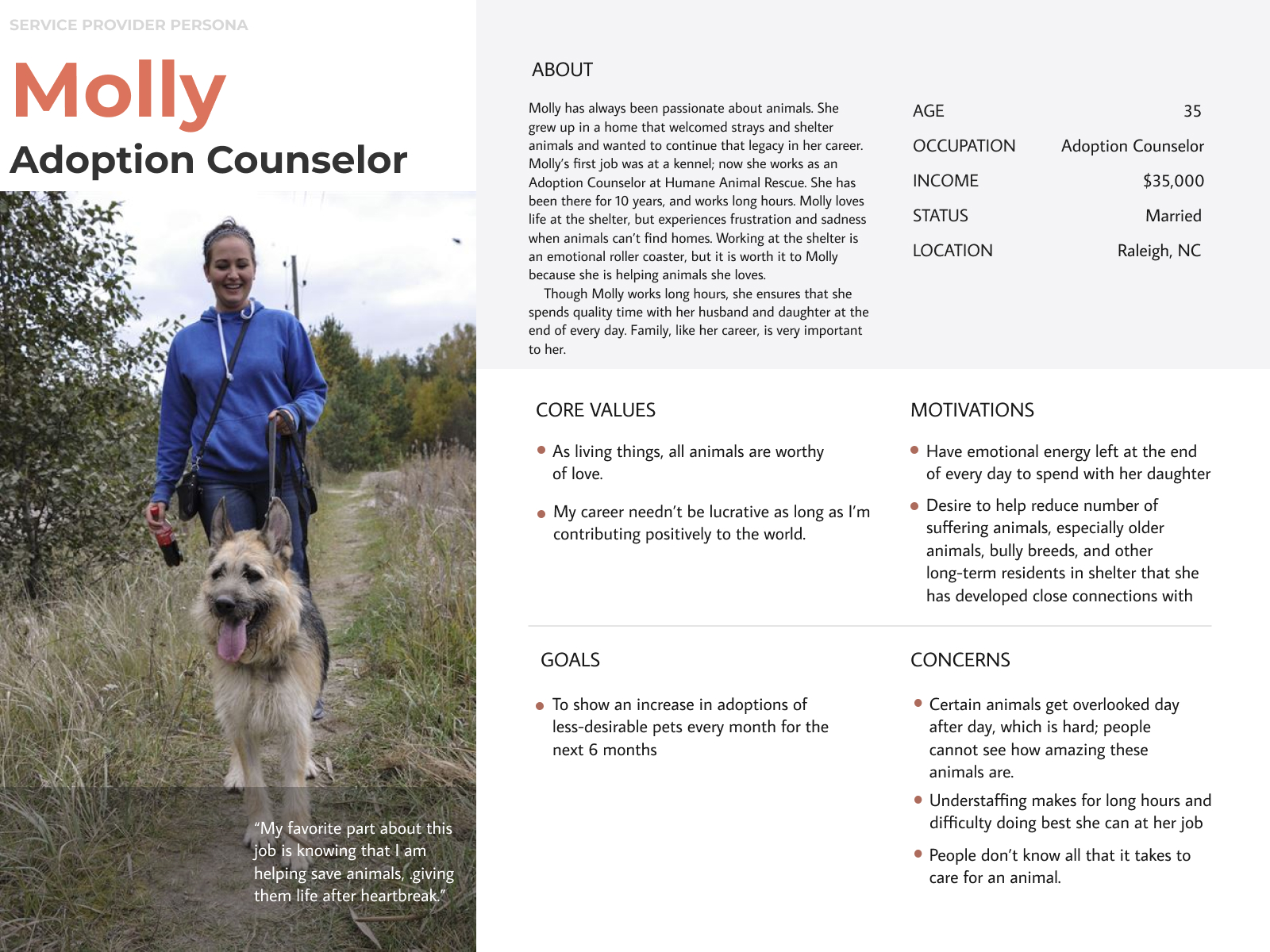
Validating our Findings
Moving forward, we used storyboarding to find ways to address both these pain points and satisfy both the customer and the service provider.
After zeroing in on a narrowed scope — how might we increase adoption dogs of that suffer from stereotypes and misconceptions? — we ideated a wide range of scenarios that would help us validate the need for a web-based solution in this area. We narrowed these scenarios down to five of the most interesting, and built out storyboards for them; we then speed-dated these concepts with past and future pet adopters to validate the need we had identified for a tool to improve adoption match-making. Through this process, we found that any concept in which a dog is commodified is undesirable to animal lovers – perhaps not surprising, but important to our design process. It was important to articulate this in order to make sure that we are honoring the value of the dogs that we were designing around, as very important but un-interviewable stakeholders.

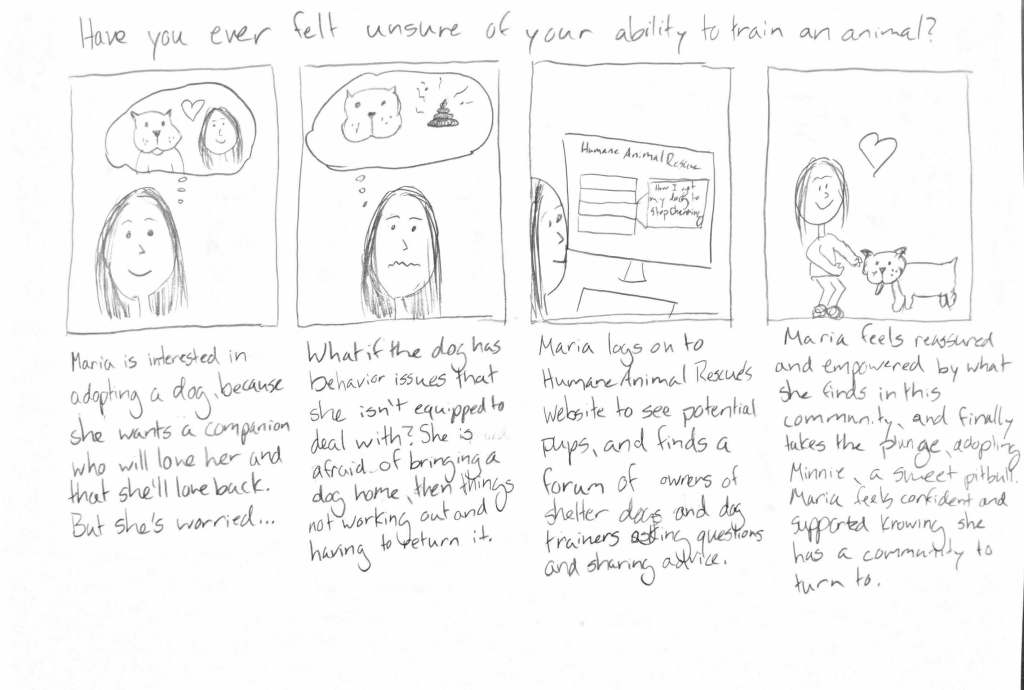
We went through two rounds of speed-dating with the storyboards we created, asking both dog adopters and adoption counselors what they thought of each in order to validate our identified needs and initial design concepts. We then iterated our storyboards based on user feedback and re-tested them. This helped us get quick and useful data about design ideas. The results easily showed that our idea for a dog matchmaking service held the most promise, so we moved forward with it.
This idea met the needs of all stakeholders found during guerrilla research; it served shelter workers by reducing the burden of under-adopted animals by raising their profiles and reducing time of stay; and by helping adopters to narrow down choice of pets, to ensure compatibility, and to prevent anxiety that comes from uncertainty during the adoption process.
Competitive Analysis
Before we began prototyping our matchmaking tool, we conducted a competitive analysis of pet-finding tools to determine how we might differentiate our product and provide new value to users. We found that popular tools like Petfinder.com primarily filter dogs by demographic characteristics like breed, age, and size; dog personality and adopter lifestyle are not part of the equation. We identified this as an opportunity for innovation in our design.
Prototyping
We decided to move forward with this scenario in our solution building phase: to remove elements like breed and age from online dog-matching, instead focusing on dog personality.
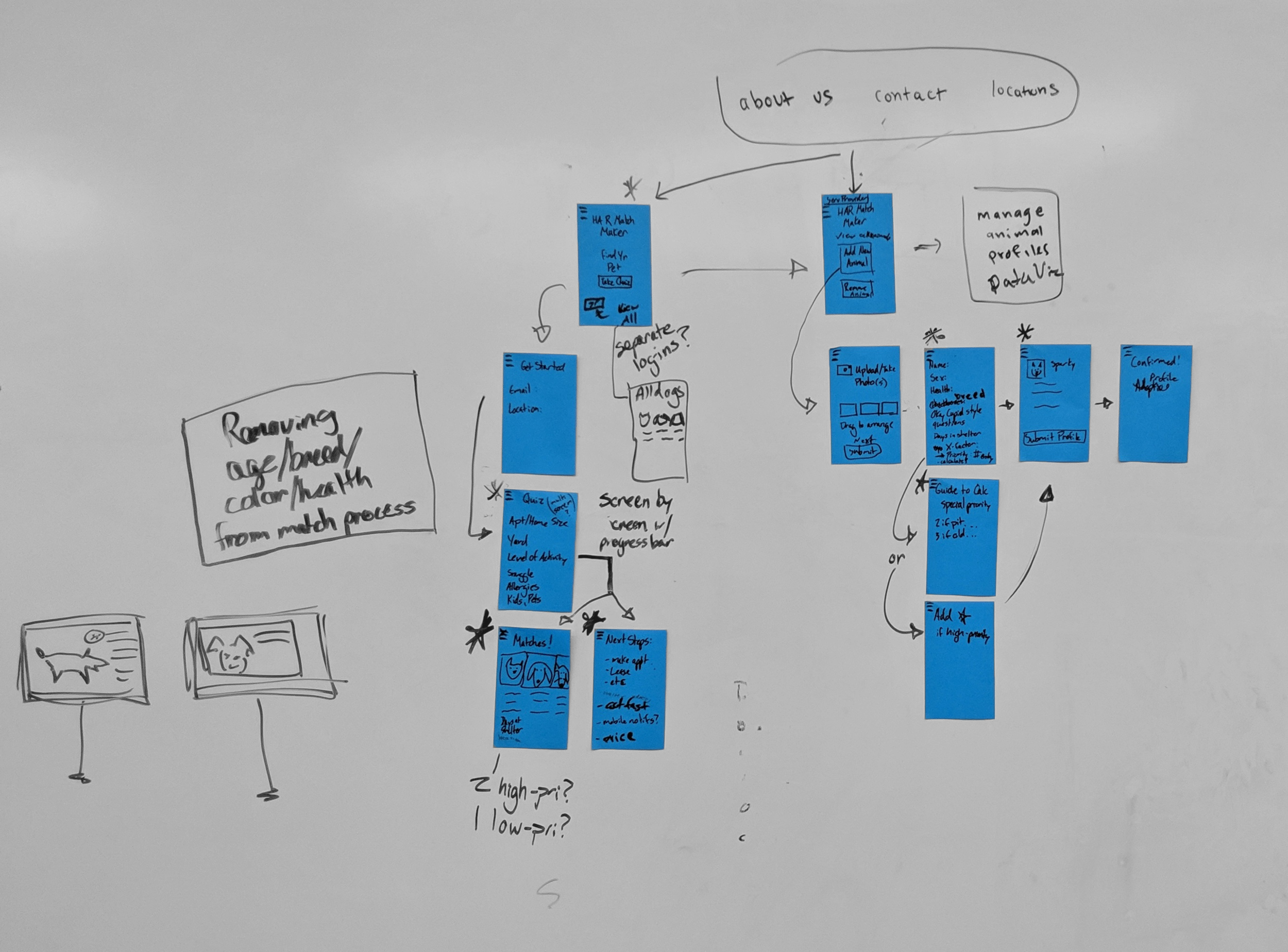
How might we use visual design to communicate not only the inclusive nature of the dog matching service, but also the playful, fun elements that people enjoy in online dating services? We also tried to bring the dogs’ personality to the forefront. We emulated dating apps like OkCupid and Tinder with our personality quiz style questions, and we used a bright and professional color palette to evoke the joys of pet ownership.
Final Concept
In order to make Kibbler an implementable digital solution to our client’s problem, we would have to add very little work to the shelter employees’ day-to-day responsibilities. The input screen attempts to do this by complementing current dog intake; the staff member adding a dog profile to the system would be able to quickly generate a biography for a new dog by selecting one of six personality types and ticking a series of checkboxes. We also created space for staff to manipulate the auto-calculated priority of a given dog based on its subcategories (old, pit bull, etc). This increases visibility of under-adopted dogs in the matches, something very important to the adoption counselors.
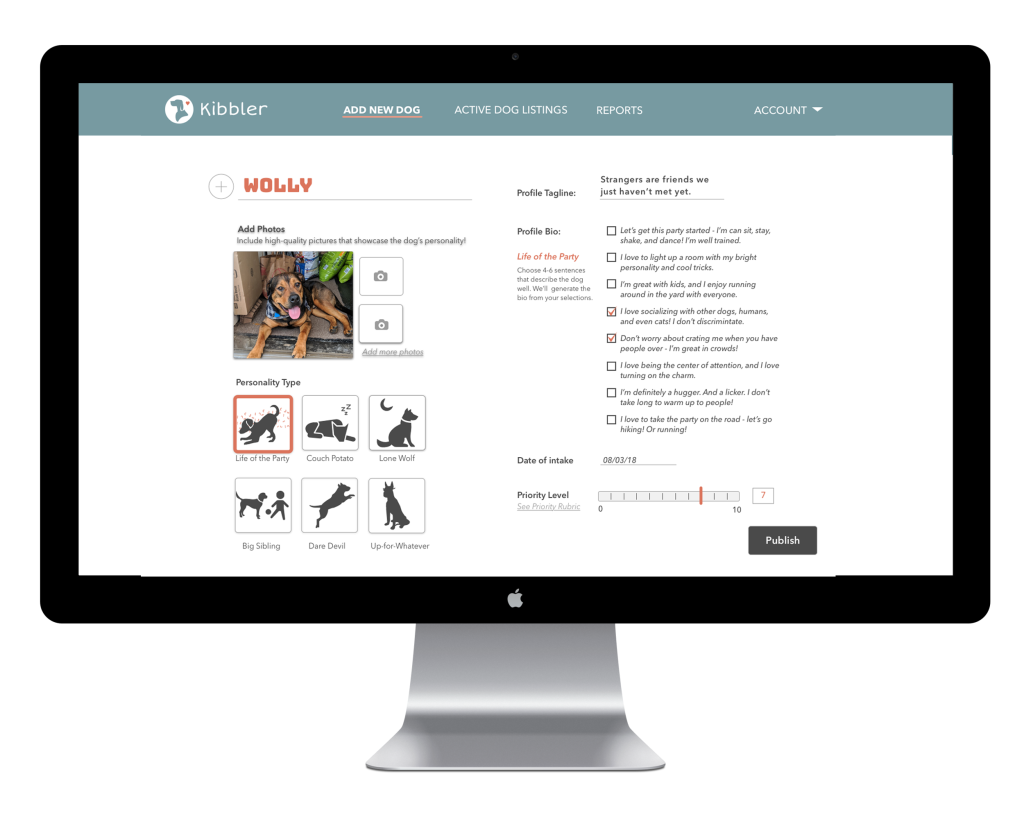
On the customer side, Kibbler’s mobile site plays out like a personality quiz. We built out a series of fun questions based on popular personality frameworks to elicit key information about potential adopters’ mindsets and lifestyles that would help identify the personality of dog that would be the best fit for any given individual. We built the customer screens for mobile web, anticipating that this mode would be suit the needs of young adopters like our persona Maria, who are often on their phones.
For the dog profile matches, we designed simple screens to ease the processing burden on potential adopters and the input burden on service providers. We aimed for these designs to help customers feel emotional connection and excitement when matched. We also designed in order to de-emphasize dog demographic information and to play up personality.
Reflection
Zeroing in on a very specific piece of the pet adoption journey was critical to our success in building a Kibbler proof of concept. In tackling the problem of finding homes for under-adopted dog populations, we focused on developing a tool that would raise the prominence of temperaments and lifestyles, while obscuring things that prospective adopters have preconceived notions about, like age and breed. This benefits the customer reducing paradox of choice and by addressing the need to be a “hero.” Kibbler also benefits the service provider by increasing the adoption rate of traditionally overlooked animals. If given more time, my team would have delved deeper into pet adopters’ journey through ethnography and contextual inquiry, as well as quantitative validation of attributes that are important to surface to the top. We also would have conducted audits of existing information systems in shelters and foster systems in order to support the adoption of more long-term shelter residents.


